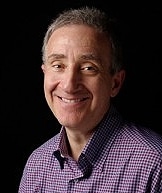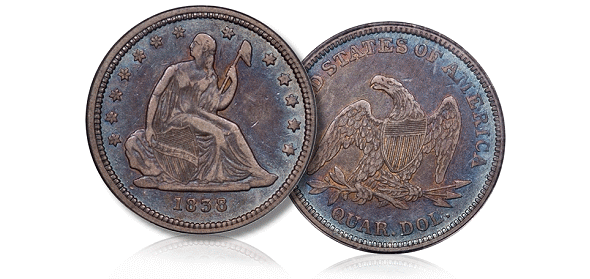By Doug Winter – RareGoldcoins.com
CoinWeek Content Partner……….
Like most dealers, I started my numismatic journey as a collector. I began a collection of 1787 Draped Bust Left colonials at the precocious age of 10 or 11, and was spending much of my pre-teen budget on coins. At around age 13 I discovered Seated Liberty quarters and was hooked. I focused on this series until the early 1980’s when I became a full-time dealer. When I started my own business in 1985, I needed money for inventory and, sadly, I sold my quarters. Ever since then, I’ve remained a dealer first and a collector a distant second.
Around six months ago, a client and friend emailed me a photo of a very pretty 1838 quarter. He wasn’t soliciting an offer; he knew that I liked the series and would no doubt appreciate the originality of said coin. Without really thinking, I answered him with an inquiry asking if the coin was for sale and if so how much it was. He quoted me a price; I said yes and didn’t give the transaction a second thought.
The coin came in the mail a few days later and I was hooked. Part of me has always wished I never sold my boyhood collection of Seated quarters and I had an “aha!!” moment. Why not start collecting the series again? I have considerably more disposable income now than I did when I was 14, I have far better access to coins, and I have a better eye now (I hope….) than I did then.
Long story short: in the last half year, I’ve steadily bought quarters and have a goal in mind: a complete date and mintmark set of 1838-1891 quarters in VF-AU grades. I’ve further refined my parameters that I only want PCGS/CAC coins, and I only want 100% original, attractive coins. I have a specific “look” that I am going for but haven’t totally figured out what I’m going to do about the macho coins in the series; these will show my level of commitment.
So as someone who last collected coins in the early 1980’s, you’re probably wondering, what do I notice that’s different in the market?
Well, for one, the players are all different. When I was buying coins, the leading rare date circulated Seated quarter dealers were Jim O’Donnell, Kam Ahwash, and Bill Greyson; all three are deceased. The coins are now (mostly) in plastic and I kind of miss touching them but don’t miss the storage issues. The grading seems tighter now, especially in the VF35 to EF45 range. And the coins seem generally less nice with a majority now dipped or overly bright and certain issues likely to be exceptionally hard to find with my criteria.
“Oh great,” you’re thinking “I have to compete against Doug for coins.” Well, you really don’t if you are a collector of rare date gold, Proof gold, early gold, and bust silver. I love these four areas but I am a dealer of these coins, not an end-user. But if you have your eyes on a perfect AU50 1849-O quarter, yep, I’m your new competition. (The good news is that I play well with others.)
What else do I notice about the Seated quarter market that’s different? A few things come to mind.
The first is the increase in collectors for varieties. Back in the day, no one cared about Seated quarter varieties, let alone knew anything about them. It seems to me that varieties are as popular—if not more popular—than the individual dates/mints themselves. I’m not really a variety person and it’s likely that I will pass on many of the scarcer issues.
The second big change is the accessibility of information. In the mid-1970’s, there were hardly any published reference works, no databases of auction appearances, and you had to rely on the small number of experts in the field to figure out what was rare and what wasn’t. Today, you can search through tens of thousands of auction appearances with the click of a mouse (or with the swipe of your finger) and this gives a sense of instant expertise that clearly never existed before.
This is not without some downside. Back in the day, my “secret date” was the 1847-O quarter. I can remember buying examples which would be, by today’s standards, in the VF-EF range for around $150-200; coins that now sell for 10X to 30X times this amount. It’s going to be hard to bring myself to pay $5,000 for a nice 1847-O.
The third and maybe the biggest change are prices. When I was collecting Seated quarters a zillion years ago, you could buy really good coins for $200 each. This just isn’t the case today, although I will say that coming from the pricey world of rare date gold, many Seated quarters seem very reasonably priced. Luckily, my budget is just a hair bigger in 2015 than it was in 1975, and it’s a lot easier for me to drop $1,000, $2,000, or $5,000 on a coin.
In 1975, the rare CC quarters were my nemesis. I could never afford a decent looking 1870-CC and while I can write a check for a nice one today, it won’t be without taking a bit of a deep breath. I guess I will cross this bridge when I come to it, but I have the feeling I’m already hooked deep enough that I will be a serious player for the CC rarities when the right coin comes along.
The impact of social media on the coin market is new and interesting as well. Back in 1975, collectors were private and closed-mouth. When I did happen to meet fellow collectors at shows, it was like pulling teeth to get them to tell me how nice their 1852-O quarter was or if they had an 1846 quarter. Today, people are keen to share information. I will probably post my set on the PCGS Registry once I have at least 25% of the coins bought; for now, my set is too new to share.
Most importantly, I am having fun with my new collection. There’s something Zen-like for me when I’m at a show and I go through a stack of Seated quarters deciding which if any I will add to my set. I now have a number of dealer sites bookmarked and check them on a regular basis, and when I get an auction catalog I never fail to note which Seated quarters are worth examining in person when I look at lots.
I love my job but I love it even more now that I’m a collector (again).
About Doug Winter
 Doug has spent much of his life in the field of numismatics; beginning collecting coins at the age of seven, and by the time he was ten years old, buying and selling coins at conventions in the New York City area.
Doug has spent much of his life in the field of numismatics; beginning collecting coins at the age of seven, and by the time he was ten years old, buying and selling coins at conventions in the New York City area.
In 1989, he founded Douglas Winter Numismatics, and his firm specializes in buying and selling choice and rare United States coins, especially US gold coins and all branch mint material.
Recognized as one of the leading specialized numismatic firms, Doug is an award winning author of over a dozen numismatic books and the recognized expert on US Gold. His knowledge and exceptional eye for properly graded and original coins has made him one of the most respected figures in the numismatic community and a sought after dealer by collectors and investors looking for professional personalized service, a select inventory of impeccable quality and fair and honest pricing. Doug is also a major buyer of all US coins and is always looking to purchase collections both large and small. He can be reached at 214-675-9897.
Doug has been a contributor to the Guidebook of United States Coins (also known as the “Redbook”) since 1983, Walter Breen’s Encyclopedia of United States and Colonial Coins, Q. David Bowers’ Encyclopedia of United States Silver Dollars and Andrew Pollock’s United States Pattern and Related Issues
In addition he has authored 13 books on US Gold coins including:
- Gold Coins of the New Orleans Mint: 1839-1909
- Gold Coins of the Carson City Mint: 1870 – 1893
- Gold Coins of the Charlotte Mint: 1838-1861
- Gold Coins of the Dahlonega Mint 1838-1861
- The United States $3 Gold Pieces 1854-1889
- Carson City Gold Coinage 1870-1893: A Rarity and Condition Census Update
- An Insider’s Guide to Collecting Type One Double Eagles
- The Connoisseur’s Guide to United States Gold Coins
- A Collector’s Guide To Indian Head Quarter Eagles
- The Acadiana Collection of New Orleans Coinage
- Type Three Double Eagles, 1877-1907: A Numismatic History and Analysis
- Gold Coins of the Dahlonega Mint, 1838-1861: A Numismatic History and Analysis
- Type Two Double Eagles, 1866-1876: A Numismatic History and Analysis
Finally Doug is a member of virtually every major numismatic organization, professional trade group and major coin association in the US.
If you are interested in buying or selling classic US coins or if you would like to have the world’s leading expert work with you assembling a set of coins? Contact Doug Winter at (214) 675-9897 or by email at [email protected].






Hi Doug,
We have never met, and collecting gold coins is pretty much out of my budget. Nonetheless, I have read and enjoyed many of your articles, including this one. I think it is really cool that your youthful passion for collecting seated quarters was spontaneously reignited. Thanks for sharing, and success with your business and collection.